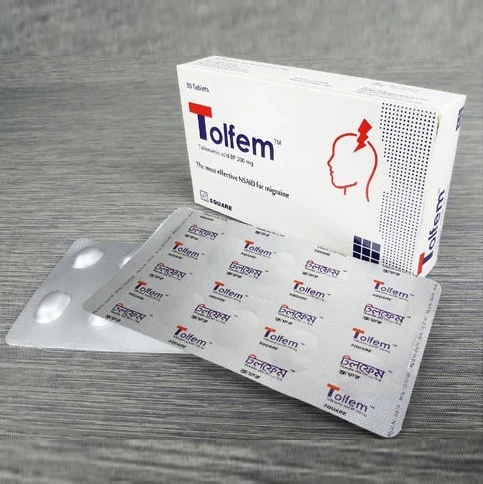Unit Price:
৳ 10.00
(3 x 10: ৳ 300.00)
Strip Price:
৳ 100.00
Indications
Tolfem is used-
- Specifically for relieving the pain of migraine headache and
- Recommended for use as an analgesic in post-operative pain and fever.
Pharmacology
Tolfenamic acid (N-(2-methyl-3-chlorophenyl) anthranilic acid) belongs to the fenamate group and is a potent inhibitor of cyclooxygenase enzyme, thus it inhibits the synthesis of important inflammatory mediators such as thromboxane (TX) B2 and prostaglandin (PG) E2. Prostaglandins are responsible for causing swelling pain and inflammation associated with these conditions. It acts not only by inhibiting prostaglandin synthesis, but it also has direct antagonistic action on its receptors.
Pharmacokinetic properties: Absorption Readily absorbed from GI tract. Peak plasma concentration: 60-90 min. Bioavailability 85%. Distribution: Protein-binding: 99% Plasma half-life 2 hours. Metabolism: Metabolised in the liver. Tolfenamic acid undergoes enterohepatic circulation. Excretion: Excreted in urine (90%) and faces.
Pharmacokinetic properties: Absorption Readily absorbed from GI tract. Peak plasma concentration: 60-90 min. Bioavailability 85%. Distribution: Protein-binding: 99% Plasma half-life 2 hours. Metabolism: Metabolised in the liver. Tolfenamic acid undergoes enterohepatic circulation. Excretion: Excreted in urine (90%) and faces.
Dosage & Administration
Adult:
Tolfenamic acid should be taken with food. Take water during or immediately after meals.
- Acute migraine attacks: 200 mg when symptoms appear may be repeated once after 1-2 hour.
- Mild to moderate pain: 100-200 mg tid
- Renal impairment: Dose adjustments may be needed.
- Severe renal impairment: Avoid.
Tolfenamic acid should be taken with food. Take water during or immediately after meals.
Interaction
The rate of absorption of Tolfem increases with Metoclopramide and Magnesium hydroxide but decreases with Aluminium hydroxide. Risk of bleeding with anticoagulants and other NSAIDS increases when use with Tolfem. It decreases antihypertensive response to loop diuretics, B-blockers and ACE Inhibitors. Co-administration increases plasma concentration of Lithium Methotrexate and cardiac glycosides. It also increases the risk of nephrotoxicity with ACE inhibitors, Ciclosporin, Tacrolimus or diuretics
Contraindications
Active gastro-intestinal bleeding, active gastro-intestinal ulceration, history of gastro-intestinal bleeding related to previous NSAID therapy, history of gastro-intestinal haemorrhage, history of gastro-intestinal perforation related to previous NSAID therapy, history of recurrent gastro- intestinal ulceration, severe heart failure.
Side Effects
Side effects which include rare alveolitis, hepatic damage, pancreatitis, pulmonary eosinophilia, Stevens-johnson syndrome, angioedema, blood disorder, depression, diarrhea, dizziness, drowsiness, dysuria, euphoria, gastro-intestinal bleeding, gastro-intestinal discomfort, hallucination, insomnia, malaise, nausea, hearing disturbances, rash, visual disturbances , vertigo, raised blood pressure. Overdose: Symptoms include headache, nausea, vomiting, gastro-intestinal bleeding, drowsiness, dizziness, occasionally convulsion. In case of significant poisoning acute renal failure and liver damage are possible.
Pregnancy & Lactation
This medicine is not recommended for using during pregnancy unless considered essential by doctor Not to be given during the third trimester of pregnancy. NSAID's can appear in breast milk in very low concentrations NSAID's should, if possible, be avoided when breastfeeding.
Precautions & Warnings
Precaution should be needed for patients with asthma bronchospasm, bleeding disorders, cardiovascular diseases, peptic ulceration, hypertension, liver infection, cardiac or renal function impairment and elderly. Increase water intake or dose reduction to reduce dysuria.
Overdose Effects
Symptoms include headache, nausea, vomiting, epigastric pain. gastrointestinal bleeding, diarrhoea excitation, coma, drowsiness dizziness, tinnitus, fainting and convulsions. In cases of significant poisoning, acute renal failure and liver damage are possible. Patients should be treated symptomatically as required.
Therapeutic Class
Drugs used for Rheumatoid Arthritis, Non-steroidal Anti-inflammatory Drugs (NSAIDs), Other drugs for migraine
Storage Conditions
Store in a cool and dry place, away from light Keep out of the reach of children.
Chemical Structure
| Molecular Formula : | C14H12ClNO2 |
| Chemical Structure : |
Common Questions about Tolfem 200 mg Tablet
What is Tolfem 200 mg Tablet?
Tolfem 200 mg Tablet is a potent inhibitor of cyclooxygenase enzyme, thus it inhibits the synthesis of important inflammatory mediators such as thromboxane (TX) B2 and prostaglandin (PG) E2.
What are the uses of Tolfem 200 mg Tablet?
Tolfem 200 mg Tablet is used for the treatment of acute migraine attacks and Mild to moderate pain.
Quick Tips
- Tolfem 200 mg Tablet should be taken with food or milk to avoid getting an upset stomach.
- Tolfem 200 mg Tablet can cause serious complications like stomach bleeding and kidney problems if taken for a long time.
- Tolfem 200 mg Tablet can raise your risk of blood clots, heart attack, or a stroke.
- Inform your doctor if you are pregnant or planning to conceive or breastfeeding.
- Inform your doctor if you have ever been diagnosed with kidney or liver problems.


